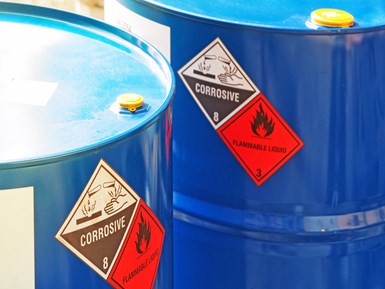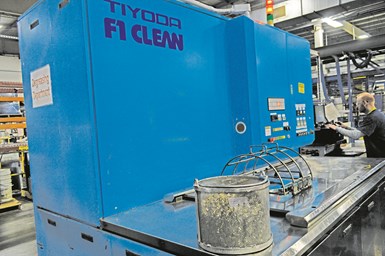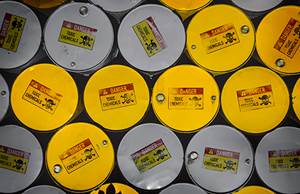How EPA Decisions Might Affect Surface Preparation
Last year, the EPA determined that four degreasing solvents used in parts cleaning pose “unreasonable risks” to workers. By the end of 2022, there should be new rules outlining restrictions on how the solvents can be used. Solvent bans are possible. What should surface finishing companies do?

Last year, the EPA found “unreasonable risks” to workers for four degreasing solvents. The agency could restrict the availability and costs of these solvents by the end of 2022.
The U.S. Environmental Protection Agency (EPA) is moving expeditiously toward actions that could restrict the availability and costs of cleaning agents that the world of surface finishing has come to depend on. Some suppliers of cleaning agents and cleaning machines have been quick to forecast complete solvent bans and to urgently suggest that potential customers immediately change the cleaning process to one using their product offerings. No one can predict what steps the EPA will take; final decisions have not been made. While it is tempting to assert that all fabricators and surface finishers must immediately hire critical cleaning consultants, a proactive approach is suggested. This involves becoming educated about various cleaning options and progress of regulatory activities. Many sources of information are available; it is important to read critically, evaluate critically and clean critically.
The EPA is moving relatively rapidly because, in 2016, the Frank R. Lautenberg Chemical Safety for the 21st Century Act became law with broad-based congressional support. The law amends the Toxic Substances Control Act (TSCA). Traditionally, the EPA looked primarily at impacts on the environment. The new law (sometimes referred to as “Lautenberg” or “TSCA Reform”) brings the EPA further into the field of worker exposure, an area that had been previously considered to be the purview of the Occupational Safety and Health Association (OSHA). Among other things, the law mandates the EPA to review the uses of existing chemicals for unreasonable risks to human health or the environment. By the end of 2020, the EPA issued a final risk assessment on the first 10 chemicals that it considers as the highest priority, including four degreasing solvents: methylene chloride (MC), trichloroethylene (TCE), perchloroethylene (PCE), and n-propyl bromide (nPB).
The concern, particularly for product manufacturers, is that the EPA finds “unreasonable risks” to workers for all four cleaning agents as they would be used in vapor degreasing operations. An additional degreasing solvent, trans-1,2-dichloroethylene (trans-DCE), has not yet been evaluated for risks but will be in the next tier of prioritized chemicals.
Once a risk assessment has been finalized, the EPA must propose a rule to mitigate the risks within one year and finalize the rule within two years. That means that all four solvents are mandated to have final rules in place by the end of 2022. Final rules may include a timeline for developing and implementing process changes, process controls or bans.
Many manufacturers think that because plating and anodizing use water-based processes, surface preparation before finishing can use aqueous cleaning, not solvents. However, for the aqueous processes in surface finishing to be successful, the residue of metalworking fluids must first be thoroughly removed from parts. This is easier said than done. Creating the product to be plated involves metalworking fluids. The heat and force involved in fabrication alter these fluids, leaving a residue that can be very difficult to remove and can interfere with subsequent surface finishing. Even water-soluble lubes can leave a residue that is not water-soluble. In addition, when the residue of metalworking fluid is trapped in blind holes or crevices, it can leach out gradually over time. A part may look clean initially, but it may become contaminated over the course of days or even weeks. Therefore, parts held in inventory or received from suppliers or customers may show surface defects after finishing unless they are appropriately cleaned.

Once a risk assessment has been finalized, the EPA must propose a rule to mitigate the “unreasonable risks” within one year and finalize the rule within two years.
To avoid such coating problems, some suppliers and shops have used vapor degreasers. nPB has been widely used, in part because it has not been subject to the constraints of the National Emission Standard for Hazards Air Pollutants (NESHAP). These constraints include equipment design, practices during the cleaning process and recordkeeping. Other shops and suppliers use what is often referred to as the “NESHAP solvents” — MC, TCE and PCE. Most degreasers, including those with a cover, are considered “open top”; if the cover is opened, there can still be chemical vapor and/or liquid present.
A few manufacturers use “airless” or “airtight” degreasers that provide excellent containment of the solvent, with very low emissions to the environment and very low worker exposure. In an airless system, if a worker opens the top to add or remove parts, there is no detectable solvent liquid or vapor. The terminology for airless systems has been around for some time. Definitions are not necessarily clear or universal. It will be helpful when a clear definition of an airless system is developed for regulatory documents, one that involves both structural descriptions and functional performance. Airless systems incur a significant capital investment and, because they are more complex in design, they must be carefully maintained, much more so than would an open-top degreaser.
As of the time of writing this, a quantifiable exposure level associated with “unreasonable” has not been published. It is logical that these numbers are likely to be lower, perhaps much lower than those published by groups such as OSHA, the American Industrial Hygiene Association (AIHA) or the America Conference of Governmental Industrial Hygienists (ACGIH). These critical levels are likely to be different among the four solvents. Until these levels are established, it is difficult to determine conditions where there would not be an unreasonable risk.
So, what might happen? An outright ban on the use of all four of the solvents is possible but unlikely. There are fewer Draconian scenarios. For example, a manufacturer might be able to use one of the four solvents in an airless system. It is possible (although it seems less likely) that an open-top degreaser could be allowed under certain conditions. Or the EPA might consider the risk of one or more of the four solvents to be excessive even in an “airless” degreaser. Manufacturers could move to trans-DCE for some applications; recall that the EPA is also doing a risk evaluation for trans-DCE. Solvents containing trans-DCE could be an option if they clean well and if the EPA determines that there is not an unreasonable risk. However, because it is flammable, trans-DCE is nearly always sold as blends with a hydrofluoroether (HFE) or hydro-fluoro olefin (HFO) (sometimes referred to as “designer solvents” because they are more expensive). HFE or HFO suppresses the flashpoint; the trans-DCE provides the bulk of the cleaning power. The price of the “designer solvents” means that they should be properly contained to

Many machine shops and surface finishing facilities use vacuum vapor degreasing units, such as this one, to achieve what is hoped to be the best cleaning results for their customers. But four of the solvents used in these cleaning systems are being scrutinized by the EPA. What should be these companies’ next steps?
avoid losing costly solvent to the air, so even with those solvents, an airless system might be the most economical, albeit still costly, solution. Even if they are allowed by regulation, trans-DCE blends may not be suitable, because the boiling point of such blends tends to be low relative to classic chlorinated or brominated solvents, and heat provides energy for active cleaning.
Some manufacturers involved in surface finishing feel they need not worry because providers of cleaning agents will modify the course of regulatory reform or come up with a magic, cost-effective substitute. Suppliers already offer chemicals which they consider to be substitutes. The new cleaning agents may have a similar name as the one currently being used, but may have different physical and chemical properties, different costs or require new cleaning equipment.
While it is not necessary to immediately change the cleaning process, it is wise to think about other cleaning options, including aqueous processes and flammable solvents in specially designed cleaning machines. All involve process selection, evaluation and development. Most involve investment in new equipment; there may be increased costs for facility updates, insurance and permits. Many suppliers offer testing and evaluation of their own product lines. But surface finishers will still have to do the leg work (and the brain work).
About the Authors
Barbara and Ed Kanegsberg
Barbara and Ed Kanegsberg of BFK Solutions are expert consultants in surface quality and process development. Since 1994, they have been working with manufacturers to improve the value of their product through critical and precision cleaning. They are co-editors of and contributors to the two-volume "Handbook For Critical Cleaning,” second edition. Contact them at 310-459-3614 or info@bfksolutions.com.
Related Content
Parts Cleaning Sector Shifts Energy Toward Regulatory Changes
With changes in EPA regulations regarding the use of some popular cleaning fluids, cleaning suppliers and end users are readjusting business strategies and/or cleaning processes to meet new requirements.
Read MoreA ‘Clean’ Agenda Offers Unique Presentations in Chicago
The 2024 Parts Cleaning Conference, co-located with the International Manufacturing Technology Show, includes presentations by several speakers who are new to the conference and topics that have not been covered in past editions of this event.
Read MoreCool Clean’s Omega 1500 Provides Powerful, Portable Cleaning
PMTS 2023: By selecting the appropriate nozzle and making the necessary propellant pressure and temperature adjustments, the Omega 1500 can clean to a variety of surface cleanliness levels.
Read MoreSita’s CleanoSpector Measures Part Cleanliness
PMTS 2023: Handheld measuring device checks for cleanliness of parts to assure product quality as well as prior to follow-up processes.
Read MoreRead Next
VIDEO: Vapor Degreasing Process Uses TCE Replacement to Eliminate Hazardous Waste
A solid relationship with a solvent manufacturer has aided Electro-Spec Inc. with the implementation of a trichloroethylene replacement material in its vacuum degreasing unit to clean a customer’s micromachined parts more efficiently.
Read MoreSolvent Degreasing Regulations Explained
There is a current trend to exit some solvents to convert to a more environmentally preferred solvent that will comply with expected future regulations.
Read MoreSafer Cleaning Choices Replace nPB Aerosols
While worker safety is the priority, effective cleaning is necessary, too. It’s possible to have both.
Read More






















